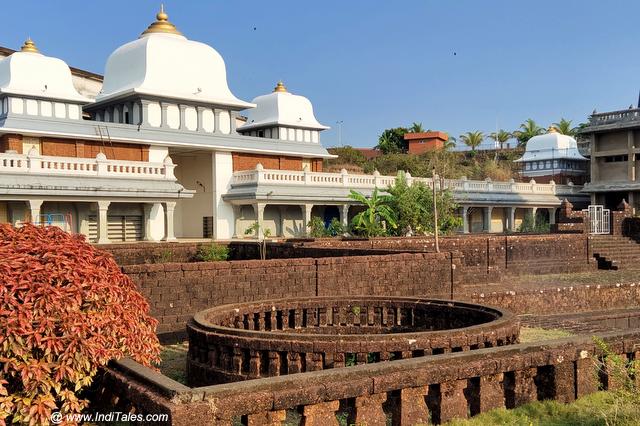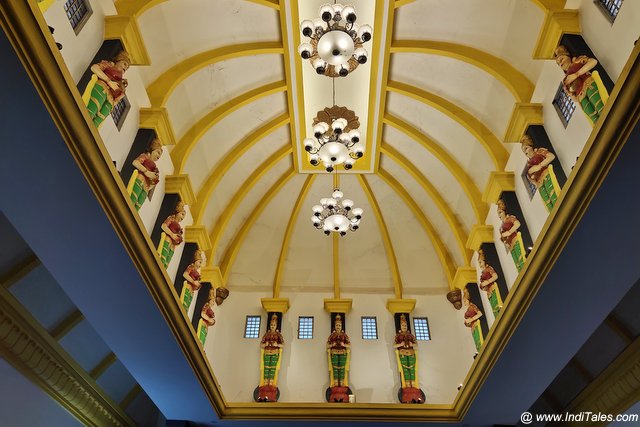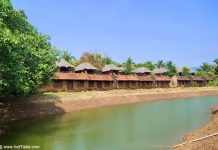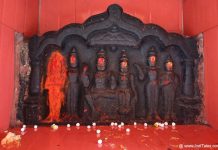Mahalasa Narayani Temple is one of the primary temples of Goa. I have visited the temple at Mardol in Ponda many times. It is a part of the Goa Temple Trail that I wrote a few years ago. However, when I started reading ancient Devi texts, I came across Mahalasa Devi mentioned many times for Gomantak. This told me that she is probably the oldest presiding deity of Goa.
Then, I read a book called ‘For the Love of Mandovi’ by Dr. Mohan Pai that talks about Goa in 16th CE when the Portuguese set foot here and started destroying the temples. The temple of Mahalasa at Veranyapuram or Varunapuram is prominently mentioned in the book. It comes across as one of the biggest temples in the region, in line with the Purana mentions.
Legends of Mahalasa Devi
As per the Purohit at the temple, many years ago, Devi came to Gomantak in the form of Vayu or Air. She tried to find herself a place in a different village before eventually settling in Veranyapura. However, the people informed her that there is a scarcity of water there. Devi then used her toe to dig a pond, from where the freshwater oozed out.

The place came to be known as Nupur Tirtha. Nupur is the toe ring worn by the Devi. Once Devi started living here, a temple came up for her. Another large tank was built with laterite stone. I feel the two tanks may have been linked through an underground spring. This became the center of the social life of Veranyapuram, which was also a big trading center.
Sagar Manthan
Mahalasa Narayani is also associated with the legend of Sagar Manthan or the Churning of Ocean story. Vishnu took the Mohini avatar to serve the Amrita churned out of the ocean. As we know an Asura by the name of Swarbhanu sat in the line of Devas to receive the elixir and was cut into two parts by the Chakra of Vishnu. It is said that as Mohini, she chased Rahu, the upper part of the body while the lower part called Ketu kept running. She killed Rahu at a hill called Mahalasa and stood over him. It is this Avatar of Vishnu that is immortalized here as Mahalasa Narayani.
She is also known as Rahu Mardini. However, I could not gather if any rituals associated with Rahu are performed here at this temple.

A local legend says that she is Mahalasa – the wife of Malhari Martand or Khandoba, a form of Shiva that is worshipped in western India. Indeed, there is a Malhari temple close by, which may have been a part of the earlier temple complex. This story is not really disconnected from the first story. It is said that Shiva was enchanted by Mohini, and he decided to take the earthly form of Khandoba to marry Mahalasa.
Yet another legend says that it was to kill the Asuras Mani and Malla that Shiva took the form of Bhairava and Parvati that of Mahalasa. As per this story, she is a form of Parvati.
Mahalasa Narayani Temple at Verna
It was time for me to visit the Mahalasa temple at Verna, which has been recently rebuilt at the very place it was first located. Verna today is the industrial district of Goa, full of factories and big offices. In fact, when I moved to Goa, this is where my office was located, not too far from the temple. It took me seven years before I could visit the temple. As they say, you can visit Devi temples only when She wants you to visit her.
Located at a foothill, it is probably one of the biggest temples in Goa.

The temple tank is also the biggest I have seen in Goa. It looks beautiful with clean laterite stone.

A circular well is located at one corner of the tank. It was so clean that I thought it has been built new with the temple, but I was told it is the old and original tank of the temple.
Do read: Divar – Heritage and Nature trail on the river island of Goa
History of Mahalasa Narayani Temple
The temple was originally located in Varunapuram now known as Verna. During the 16th CE, it was completely destroyed by the Portuguese. The temple was rebuilt in Mardol village in Ponda, where it continues to exist. A new temple has been recently built at the original site of the temple.
Other temples of Mahalasa are located in Paithan, Nevasa, Karwar, Kumta, Kasargod, and Harikhandige.
Mahalasa is a Kuldevi of many Saraswat Brahmin families and few other communities.
The architecture of Mahalasa Narayani Temple
The architecture of this new temple is very unique. It is designed as a complex, which is still a work in progress. A map at the entrance tells you about the different parts of the temple.

The main temple has a huge mandapa with a rectangular curvilinear dome. The polished granite floor reflects the hollow dome so well that when you walk on it, it almost feels like you are hanging in the air. The credit goes to the authorities for keeping it so clean. Ample stone has been used for the construction of the temple.

The new temple and ancient temple tank stand in front of each other. On one side of the temple is a school for children and on another side is the Kalyanmandapa or the hall for weddings. Well-maintained lawns surround the temple as well as the tank.
Do read: Mallikarjuna temple, Canacona, Goa & its Shisha Ranni festival
Murti of Mahalasa Narayani
The Murti of Devi is in black stone, and I was told it has been carved locally in Goa. I need to visit the carvers someday. Devi has four arms holding a Trident or Trishul, a Sword, an Asura head, and a bowl. She also wears the Yagnopavit or the sacred thread. This is a bit unusual as the thread is primarily worn by males. She stands on top of an Asura that she has probably killed.

To me, this looks like her Devi Avatar depiction. As Khandoba’s wife, she is usually depicted riding a horse with him.
On the side of the main Murti are two other finely carved Murtis. One on the left is Ardhanarishwara – the combined form of Shiva and Parvati. On the right is HariHara – the combined form of Shiva and Vishnu.
On the left of Devi is a smaller temple dedicated to Sharadamba and on the right to Adi Shankaracharya. Every temple entrance has a lovely Chandrashila just like our ancient temples used to have.

64 Yogini Temple
Outside the main temple, on the right is a temple dedicated to Swarnakarshan Bhairav. This literally means the Bhairav who can attract gold. On the right is a unique temple dedicated to 64 Yoginis. I have seen 64 Yogini temples in Odisha and MP but never knew there is one in my backyard. This temple is of course a miniature version of the bigger temples I have seen but it follows their formation.

There are 64 yoginis in a circle. All 64 names are written on the panel outside the temple. In the center is Samhar Bhairav – the Bhairav responsible for the destruction. I had goosebumps when I saw this symmetric circle and all the yoginis. The temple was closed and no one was willing to open it for me, so I could not have a closer look at the Yoginis. The only difference here was that the whole cluster of 64 yoginis is enclosed within a small temple that is covered on top. Most other 64 Yogini temples are open to the sky.
The question I now have is – Was there a 64 Yogini temple in Goa? If not, why did the new builders think of making one? How did they choose the list of 64 yoginis for this temple? Which Agamas did they follow? The quest is on.
Do read: Best places to visit in South Goa during your holidays
Festivals
Navaratri is obviously the biggest festival celebrated in any Devi temple.
Besides this, the temple celebrates Ram Navami with the Utsav Murtis of Sri Ram, and a Jhoola is organized for the occasion.
The annual festival of Mahalasa is organized from Shashthi to Ashtami or the 6-8th of the Krishna Paksha of Chaitra month. This would fall just after the Chaitra Navaratri.
Do read: Dev Deepawali or Tripurari Purnima in Goa
Nupur Tirtha and Hanuman Temple
Nupur Tirtha, the one that is believed to have been dug by the Devi is located a few hundred meters away from the main temple. It is a small square pond that is linked to an underground spring. A small temple stands at its corner with a Shivalinga inside it.

The pond is locked, so you have to see it from outside only. Next to it, a board informs that this ancient pond is part of a spring revival and water harvesting project.

Next to the Tirtha, in fact, closer to the road is a newly built Hanuman Temple. The architecture is similar to the main Mahalasa temple. On the right of Hanuman is a temple dedicated to Parashuram and on the left to Kaal Bhairav.
Malhari Khandoba Temple
This temple is also a part of Mahalasa Narayani temple but is located a few km away from it, though still within Verna industrial estate. The temple mandapa is still under construction.

There is a Shivalinga in the main temple. I found the door jamb of this temple very beautifully cared for with dwarpalas on either side.
Outside the temple, I found a small temple sheltering the remains of an old Murti along with a Trishul. A board said Shri Malharaya Namah.

As I drove back after visiting the Mahalasa and its associated temples, it felt like an intimate rendezvous with Goan history. A part of history that is mentioned in Puranas and a part of history that is being reclaimed. It gave me many more questions to explore.
Do visit this lovely Mahalasa Narayani temple complex when you visit Goa next. For more details visit the temple’s official website.














Thanks for sharing such useful info.I love your article.Thank you so much for your blog
Thanks for sharing the details on MAHALASA NARAYANI TEMPLE. It’s really helpful.
It was really enlightening about temples in Goa. Otherwise only churches came in mind whenever we hear/ read about Goa.
Thanks for sharing such amazing information about Mahalasa Narayani Temple. The blogs are useful and informative.
nice article
I consider myself a very spiritual person, so visiting temples when I travel is really important to me. Thanks for this post to have them all in one place!
It’s a great blog post on Goa
Hi, Thank you for sharing such detailed information about the temple and the diety,,
Astonished to know the cultural heritage of Goa as a Hindu temples which otherwise known for only churches,,,
Goa is full of ancient Shiva Shakti temples. We have written about a lot of them.
I just did a tour of the Mahalasa Narayani Temple at Verna in Goa this month and am very happy to report that it was a great experience! The temple is a Ganesh temple from the 17th-18th century.
The interior of the mahaparivara is made up of three parts, two on either side and one in front. In the central shrine dedicated to goddess Mahalasa, people offer prayers for emerging victorious over evils such as trauma, lottery bad luck, mental illness, etc., while some worship her for curing marriageable problems or infertility issues.
The pillars on either side have idols of Ganesh on them while there are images of Garudevi (
Its amazing blog about to travel to indian gods. if you guys wants to visit jaipur and want to travel a lots of history places and temples than contact with us or visit our website
Thanks for sharing the details on MAHALASA NARAYANI TEMPLE. It’s really helpful.
Thanks for sharing such amazing information about Mahalasa Narayani Temple. The blogs are useful and informative.
I have Read This Blog. This is Really Amazing and helpful.
Thanks For Sharing Information.
It’s an amazing blog about traveling to Indian gods.
Good Job
This is such an interesting article about Mahalasa Narayani.
The book “Swapna Saraswata” mentions this particular temple and I’m glad to see that it still exists. I hope to visit it someday. Very well written post.
I read your blog post and it was amazing they are full of information.
Really a great and informative article. I was really looking for such an informative article.
Good post to read and got to know about this place. Thanks for sharing,
Good post to read and got to know about this place.
As always I thank you for your amazing and eye-opening posts on the temples of Goa
Thank you so much for providing valuable information on Mahalasa Narayani.
Thank you very much for sharing a great information.
this is such a beautiful post on Goa
NIce tips. Very useful for a travel blogger like me.
Good
Great Post! I really enjoyed reading this! It’s so well written. Thanks for sharing these beautiful photographs! I love them all
Thanks for sharing such amazing information
this is such a beautiful post
Nice Post
Thanks for doing this right up. In fact you have covered this topic wholesome to the extent even we know about our kuladevi. Good research done. It will help many non konkani people know about the heritage and culture of konkani people